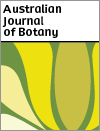Australian Journal of Botany
Volume 70
Number 8 2022
Australia is home to a diverse assemblage of plant species that display synchronised inter-annual variation in flower or seed output (i.e. masting). These plants include a semelparous masting bamboo, numerous iteroparous gymnosperms and angiosperms, and a diverse assemblage of species with fire-related forms of masting such as pyrogenic flowering and environmentally predictive masting. Here, we review the ecology and evolution of these species and provide recommendations for conservation and management of the systems they occur in.
Slime moulds are a unique group of fungus-like Amoebozoans that feed on bacteria and other microorganisms. Some slime moulds appear to be restricted largely to succulent plants, and we provide herein the first data on those species associated with invasive cacti in Australia. We report 12 species on members of the cactus family in Australia and provide data on the similarities between the assemblages of succulent-associated slime moulds in Australia and those in other regions of the world where cacti are native.
Flowering of the invasive species Acacia longifolia was assessed in three locations of Portugal, with variable environmental conditions to characterise its reproductive strategy. From northern to southern of Portugal, and from a within-plant perspective, we observed similar flowering performances in plants along the coast. Flowers and pollen are short-lived, possibly counterbalancing the massive quantities produced every flowering season.
The Brazilian Cerrado is the savanna with the highest plant richness in the world, which can be explained by the complexity of its habitats, but this richness is threatened by agriculture and cattle ranching. We show that plant richness in a mosaic of Cerrado vegetation is promoted by species substitution among habitats and is under the effect of soils. We conclude that the maintenance of plant species richness will be possible only if we also preserve all habitats that make up the Cerrado.









